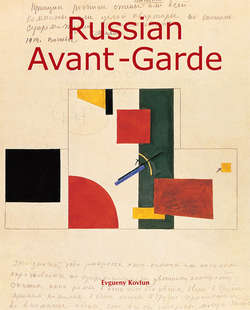Читать книгу Russian Avant-Garde - Evgueny Kovtun - Страница 3
I. Art in the First Years of the Revolution
‘Picasso, this is not the new art.’
ОглавлениеAt the beginning of the twentieth century Russian art found itself at the cutting edge of the world’s artistic process. The decades dedicated to the renewal of pictorial art in France were condensed into approximately fifteen years in Russia. The 1910s were marked by the growing influence of Cubism, which in turn modified the ‘profile’ of figurative art itself. But around 1913, the break up could already be felt, with new visual issues emerging and the scales tipping toward the Russian Avant-Garde. In March 1914, Pavel Filonov declared that ‘the centre of gravity of art’ has been transferred to Russia[1].[2] In 1912, Filonov criticised Picasso and Cubo-futurism, saying that it ‘leads to an impasse by its principles.’[3] This statement came at a time when this movement was triumphing in Russian exhibitions. The most sensitive Russian thinkers and painters saw in Cubism and in the creations of Picasso not so much the beginning of a new art but the outcome of the ancient line of which Ingres was the origin.
Nicholas Berdiaev: ‘Picasso, this is not the new art. It is the conclusion of a bygone art.’[4] Mikhail Matiushin: ‘Thus, Picasso, decomposing reality through the new method of Futurist fragmentation, follows the old photographic process of drawing from nature, only indicating the scheme of the movement of planes.’[5] Mikhail Le Dantyu: ‘It is profoundly incorrect to consider Picasso as a beginning. He is perhaps more of a conclusion, one would be wrong to follow this path.’[6] Nikolai Punin: ‘One cannot see in Picasso that it is the dawning of a new era.’[7] The French Cubists have stopped at the threshold of non-figuration. Their theorists wrote in 1912: ‘Nevertheless, let’s confess that the reminiscence of natural forms cannot be absolutely disowned, at least not for the moment.’[8] This Rubicon was then resolutely transgressed by Russian art in the work of Wassily Kandinsky and Mikhail Larionov, Pavel Filonov and Kazimir Malevich, Vladimir Tatlin and Mikhail Matiushin. The consequences of this approach have been visible for a long time in Russian art, particularly in the 1920s, although non-figurative painting only interested artists for a short period of time. Malevich presented, for the first time, forty-nine Suprematist paintings at the exhibition that opened 15 December 1915 at the gallery of Nadeshda Dobytshina on the Field of Mars (Petrograd). ‘The keys to Suprematism’, he wrote, ‘lead me to a discovery that I am not yet aware of. My new painting does not belong exclusively to the earth. Earth is abandoned like a house eaten from within by woodworm. And there is actually in man, in his conscience, an aspiration for space, a desire to detach himself from Earth.’[9]
1
All the quoted publications are in Russian, except in note 7.
2
P. Filonov, The Intimate Studio of Painters and Draughtsmen, ‘The Made Paintings’, St Petersburg, 1914.
3
P. Filonov, The Canon and the Law, Directory of the Manuscripts Department of the Pushkin House, 1912, f.656.
4
N. Berdiaev, ‘Picasso’, Sofia, 1914, No. 3, p.62.
5
Matiushin, The Work of Pavel Filonov, Directory of the Manuscripts Department of the Pushkin House, 1977, Leningrad, 1979, pp.233–234.
6
M. Le Dantyu, Letter to O. Liachkova, 1917, Manuscripts Department of the Russian Museum, f.135, op. 3, f.2.
7
N. Punin, Tatlin (Against Cubism), Petrograd, 1922, p.7.
8
A. Gleizes and J. Metzinger, On Cubism, 4th edition, St Petersburg, 1913, p.14.
9
K. Malevich, Letter to M. Matiushin dated June 1916, Directory of the Manuscripts Department of the Pushkin House, 1974, Leningrad, 1976, p.192.
